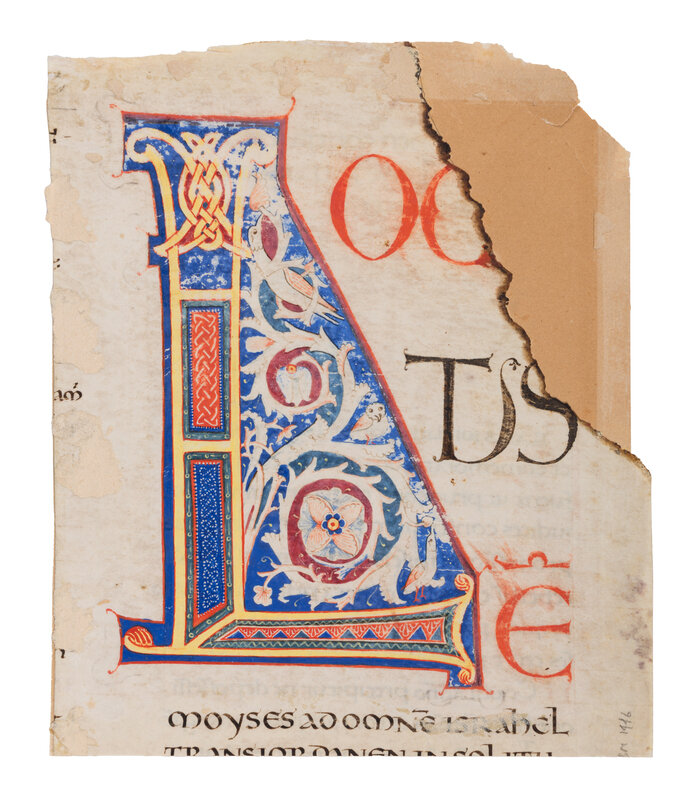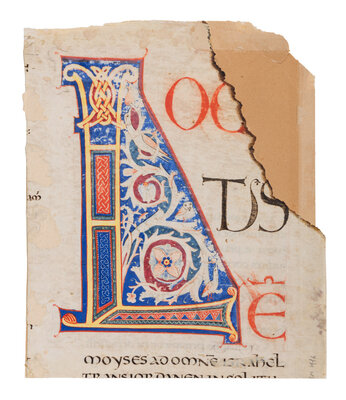Lot 3
ITALIAN ROMANESQUE ARTIST
A partial leaf from an “Atlantic” Bible, with illuminated initial ‘L’, in Latin, illuminated manuscript on parchment [Italy, Tuscany (Florence or Siena?), c. 1150-1175]
A partial leaf from an “Atlantic” Bible, with illuminated initial ‘L’, in Latin, illuminated manuscript on parchment [Italy, Tuscany (Florence or Siena?), c. 1150-1175]
Sale 2033 - Western Manuscripts and Miniatures
Jun 27, 2024
10:00AM CT
Live / Chicago
Own a similar item?
Estimate
$3,000 -
4,000
Price Realized
$3,175
Sold prices are inclusive of Buyer’s Premium
Lot Description
ITALIAN ROMANESQUE ARTIST
A partial leaf from an “Atlantic” Bible, with illuminated initial ‘L’, in Latin, illuminated manuscript on parchment [Italy, Tuscany (Florence or Siena?), c. 1150-1175]
A partial leaf from an “Atlantic” Bible, with illuminated initial ‘L’, in Latin, illuminated manuscript on parchment [Italy, Tuscany (Florence or Siena?), c. 1150-1175]
Imposing initial from perhaps one of the largest “Atlantic” Bibles, with two birds and an owl perched on white vine stems.
175 x 150 mm. Partial leaf, ruled by knife or stylus for one column (of originally two) with 22 remaining lines, written in black ink in elegant Carolingian miniscule, opening words of the text following the initial in sizable Lombardic capitals in red and black, ONE EXCEPTIONALLY LARGE SEVENTEEN-LINE ILLUMINATED INITIAL in yellow on blue ground, outlined in red, in a very elaborate interlacing design infilled with geometric compartments of yellow, green, blue, orange, and red ornaments, the stem of the letter terminates in intricate knotwork, very lush white vine stems sprouting from the bottom and growing into flowers at the end, with a bird perched on top (black ink faded, capitals in red rubbed and partially smudged, tape stains in the margins, flaking of pigment in the initial, burnt and torn on the upper right corner, pasted on passe-partout, else in good condition)
This partial leaf is from an exceptionally large “Atlantic” Bible, perhaps one of the largest (of the twenty-two Italian giant Bibles described in Cahn 1982, only three are comparable in size or bigger), written in Tuscany in the third quarter of the twelfth century. It contains the beginning of Deuteronomy, reading on the recto “Locutus est Moyses ad omnem Israhel trans Iordanem in…,” introduced by a handsome illuminated initial ‘L’, for “Locutus,” subdivided into various segments and interlaced patterns and knots according to the design principles of the later Geometric style (Garrison 1953-62, 1993).
The high quality of the leaves and their style link them to twelfth-century Tuscan illumination. Stylistic reasons suggest a date towards the later years of the third quarter of the twelfth century. Freuler finds the same style in two of the early manuscripts in the Biblioteca Comunale degli
Intronati in Siena (MS G.I.I; MS F.I.5) and in the fragments from a Homiliary in the Fondazione Giorgio Cini in Venice (inv. 22002).
Provenance
Robert McCarthy, London, MS BM 144.
Sister leaves
There are a few sister leaves excised from the same unknown Atlantic Bible on the market, as indicated not only by style but also by the common damage in the torn right-hand or left-hand corners. Two further leaves are in the McCarthy Collection, published together with the present one as no. 12 in his catalogue (see below).
LITERATURE
On the present leaf and sister leaves, published: Sotheby’s, London, 19 June 1990, lot 23; Gaudenz Freuler and Georgi Parpulov, The McCarthy Collection, Vol. I, Italian and Byzantine Miniatures, London, 2018, no. 12c, pp. 37-39 (with further literature).
We are grateful to Gaudenz Freuler for permission to quote from his catalogue for this entry. Freeman’s | Hindman thank Senior Consultant Sandra Hindman and Elliott Adam for their assistance in preparing this sale.
The Collection of Robert McCarthy
Condition Report
Contact Information

